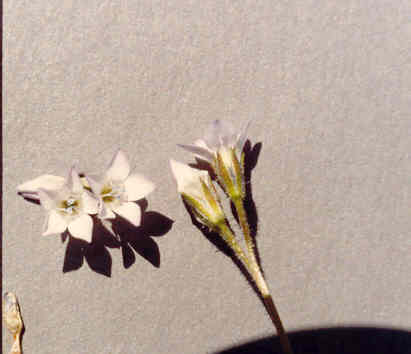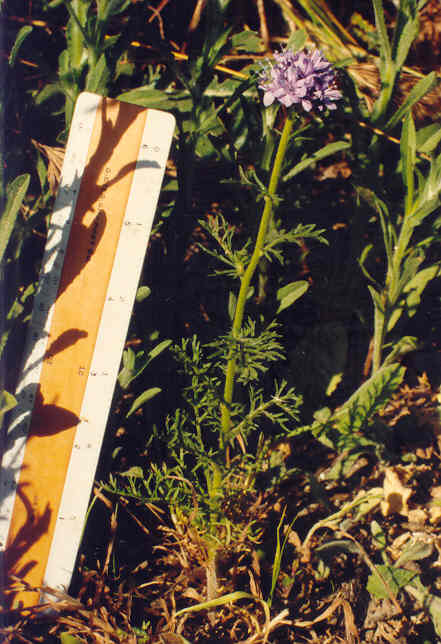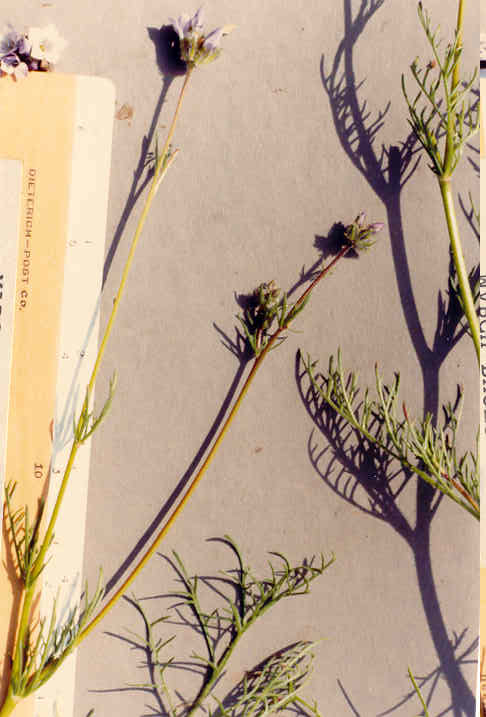
Gilia capitata Sims
ssp. abrotanifolia (Nutt. Ex Greene) V. Grant.
 |
Gilia capitata Simsssp. abrotanifolia (Nutt. Ex Greene) V. Grant.
Polemoniaceae (Phlox Family)NativeBlue Field GiliaBall Gilia |
March Photo
Plant Characteristics:
Annual, commonly branched from base, 2-8 dm. high, floccose or glabrous
below and glandular or glabrous above; lower lvs. unipinnately or bipinnately
dissected, the ultimate segms. 0.5-2 mm. wide, the axils of lvs. usually
floccose; heads several, on naked peduncles 4-25 cm. long, 1.5-3 cm. in diam.;
pedicels 1-2 mm. long; calyx composed of relatively narrow herbaceous bands and
narrow to broad hyaline sinuses, greenish to purplish-brown, lightly floccose,
the acuminate lobes recurved at tip; corolla 8-12 mm. long, light blue-violet to
whitish, the oval lobes 1.5-3 mm. wide; fils. 2-4 mm. long; anthers blue, style
1-3 mm. longer than corolla; seeds 9-13, ovoid, 1-1.5 mm. long.
Habitat:
Loose sandy places below 6000 ft.; Coastal Sage Scrub, Chaparral, Yellow
Pine F., etc.; near the coast from Santa Barbara Co. s., inland to Tehachapi
Mts., Santa Ana Mts., etc. to L. Calif.; Santa Catalina and Santa Cruz Ids.
April-May.
Name:
The genus was named for Filippo Luigi Gilli, 1756-1821, director
of the Vatican Observatory, who collaborated on a botanical work with the
Spaniard Caspar Xuarez (born in Paraguay in 1731 and died in Rome in 1804).
(Dale 154). Munz, Flora So
Calif. 644, indicates that the genus was named for Felipe Gil, a
Spanish botanist. John Johnson says
that Gil and Gilli and are same person with a different name
spelling. Latin, capitatus,
having a head. (Jaeger 46).
The species name refers to the rounded head of clustered flowers.
(Dale 154).
General:
Uncommon the study area. Found
on the bluffs above 23rd St. and across the bay on the bench below Eastbluff.
Photographed in both places. In
1995, a single plant was found growing on the 23rd St. flats. On 5/19/01,
several small plants were found on the Shellmaker dune. (my comments).
G. aggregata was used for the blue dye in its roots and as a blood
purifier by the Nevada Indians. The
Utes boiled the whole plant for glue. (Murphy
56). Indians
used the whole plant of Gilia spp. for tea for children.
(Murphy 37).
A genus of about 50 species, Calif. and S. America.
(Munz, Flora So. Calif. 644).
Text Ref:
Abrams, Vol. III 463; Hickman, Ed. 832; Munz, Flora So. Calif.
648; Roberts 32.
Photo Ref:
March 3 85 # 22,23; Feb-Mar 86 # 17,19; April-May 95 # 22.
Identity: by R. De Ruff, confirmed by F. Roberts.
Computer Ref: Plant Data 251.
Have plant specimen.
Last edit 5/30/03.
 |
 |
April Photo March Photo